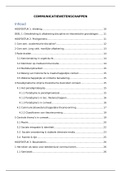Summary
Samenvatting Communicatiewetenschap
- Course
- Institution
- Book
Samenvatting Communicatiewetenschap: het handboek Communicatie & Media en eigen notities van de les in 1. Ik ben zelf geslaagd met een 14/20 voor dit vak o.b.v. mijn samenvatting.
[Show more]













